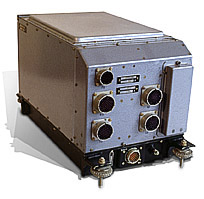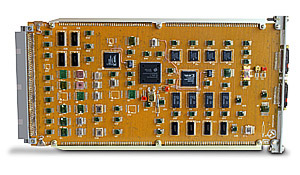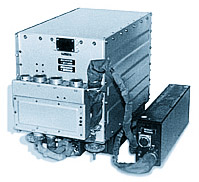C100 and C101 Computers
Home → Articles → C100 and C101 Computers
- C100 and C101 airborne computers.
- Chief designer: A. A. Solovyov.
Development engineers: B. Yu. Kurbatov, V. M. Brekhov, V. I. Levshin, Yu. S. Gorshenin, A. A. Alekseyev, A. A. Chizhov, B. I. Yurgayev.

C101 Computer
- Designing organization: Research Institute of Computer Engineering (NICEVT) of the USSR Ministry of Radio Engineering (since 1986 - Research Institute NII Argon).
- Manufacturer: Oktyabr GPPO, Kamensk-Uralsky.
- Completion of development: 1982 (C100); 1991 (C101, C102).
- Beginning of production: 1983 (C100); 1991 (C101, C102).
- Termination of production: still in production.
- Field of application: weapon control systems for MIG-29, Su-27 and Su-35 fighter aircraft.
- Total output of machines: over 4,000.
- Description: C100 family comprises different versions of C100 machine whereas C101 family consists of C101 and C102 computers and their modifications. All computers are based on the proprietary POISK architecture developed at NII Argon, which allows adapting an instruction set to control system functions by expanding the basic instruction set with microcodes inherent in specific tasks.
The instruction set includes usual command-type cast operators, operators with a more complex structure, special operators such as exchange and operating system and user operators. All the operators can have a different bit length. The number of operators depends on the machine application and can vary from 157 to 256.

C101 cell
According to researches and service experience, POISK-based airborne computers outperform usual single-address machines using the same elements by the factor of 1.5 to 2.5 in productivity and threefold to fivefold in code compactness. It is especially important for airborne machines with tough restriction on weight and dimensions.
C100 and C101 airborne computers are 16-bit synchronous multiple-address machines with parallel processing. They are based on a bus-module architecture with firmware control. The computers consist of a CPU, RAM, ROM and an I/O device. The latter is used to interface with system hardware. C101 and C102 models are based on a dual-bus architecture. One interface is fast synchronous and the other is a slower asynchronous internal bus. C102 can be used as a part of a two-machine system consisting of C101 and C102 computers. Such a system is controlled by C101 machine through intercomputer communication adapter.
Representation of numbers - fixed point; data word length - 16 bits, instruction word length - variable.
Model C100 C101/C102 Performance, operations per second 170,000 400,000 RAM capacity, Kbytes 8 16 ROM capacity, Kbytes 136 128/256/384 Number of I/O channels 1 1 or 2 Channel throughput, Kbps from 400 to 800 from 400 to 800 Number of input/output lines 18/16 24/16 Number of single input/output commands 9/3 10/10 or 8/6 Number of programmable timers 1 2 Request response time 100 ms 50 ms Number of request lines 2 4 Interrupt system:
Number of interrupt levels - 7.
- Element base: 106, 133, 134 and 136 families of medium scale integration ICs for C100; 1802, 1804, 530 and 533 family ICs for C101/C102.
- Design: modular design with a three-level hierarchy (board - cell - unit). A cell consists of two boards, one of which has a connector installed. The boards are electrically connected by point-to-point wiring; they are mechanically attached to a light-weight bearing and guiding frame. The connections between cells are made of wires by wire wrap method. The cells of functional devices and power supply unit are installed in a common case in the form of a built-up shock-proof assembly with forced air cooling.
- Technology: multilayer printed circuit boards made by metal coating of through holes.
- Software: a set of programs and microcodes comprising special and general-purpose software. Special software consists of applications, interruption processing codes and programs for data exchange with external devices. General-purpose software includes the SAPOD system (automated system for programming, debugging and documenting of object programs). YaSKO operator symbolic coding language is used for input.
- Specifications:

C100 Computer
Range of operating temperatures - from - 55 to +60°C.
Sinusoidal vibrations (C100) - 5 g (in the frequency range of 20-2,000 Hz).
Root-mean-square vibration acceleration (C101/C102) - 3.2 g (in the frequency range of 20-2,000 Hz).
Linear acceleration - 10 g (C100); 13.5 g (C101/C102).
Relative air humidity at 35°C - 98% (C100); 100% (C101/C102).
Barometric pressure - 15 mm Hg.
Mass - 32 kg (C100); 19 kg (C101); 18.7 kg (C102).
Volume - 48 q. dm. (C100); 26 q. dm. (C101/C102).
Power consumption - 275 W (C100); 260 W (C101); 240 W (C102).
MTBF - 500 h (C100); 1,000 h (C101/C102).
- Special features: POISK architecture allows adapting an instruction set to tasks handled. By the production volume (over 4,000 machines) these computers are one of the most full-scale produced airborne machines.



